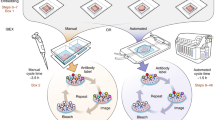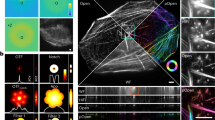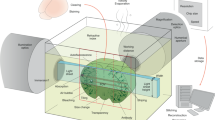Abstract
The correlation of light and electron microscopy of complex tissues remains a major challenge. Here we report near-infrared branding (NIRB), which facilitates such correlation by using a pulsed, near-infrared laser to create defined fiducial marks in three dimensions in fixed tissue. As these marks are fluorescent and can be photo-oxidized to generate electron contrast, they can guide re-identification of previously imaged structures as small as dendritic spines by electron microscopy.
This is a preview of subscription content, access via your institution
Access options
Subscribe to this journal
Receive 12 print issues and online access
$259.00 per year
only $21.58 per issue
Buy this article
- Purchase on Springer Link
- Instant access to full article PDF
Prices may be subject to local taxes which are calculated during checkout


Similar content being viewed by others
References
Lichtman, J.W. & Fraser, S.E. Nat. Neurosci. 4 (Suppl), 1215–1220 (2001).
Bourne, J.N. & Harris, K.M. Annu. Rev. Neurosci. 31, 47–67 (2008).
Rhodin, J.A. & Fujita, H.J. Submicrosc. Cytol. Pathol. 21, 1–34 (1989).
Polishchuk, R.S. et al. J. Cell Biol. 148, 45–58 (2000).
Mironov, A.A. & Beznoussenko, G.V. J. Microsc. 235, 308–321 (2009).
Grabenbauer, M. et al. Nat. Methods 2, 857–862 (2005).
Sosinsky, G.E., Giepmans, B.N., Deerinck, T.J., Gaietta, G.M. & Ellisman, M.H. Methods Cell Biol. 79, 575–591 (2007).
Knott, G.W., Holtmaat, A., Trachtenberg, J.T., Svoboda, K. & Welker, E. Nat. Protoc. 4, 1145–1156 (2009).
Li, J., Erisir, A. & Cline, H. Neuron 69, 273–286 (2011).
Darcy, K.J., Staras, K., Collinson, L.M. & Goda, Y. Nat. Neurosci. 9, 315–321 (2006).
Watanabe, S. et al. Nat. Methods 8, 80–84 (2011).
Mishchenko, Y. et al. Neuron 67, 1009–1020 (2010).
Kerschensteiner, M., Schwab, M.E., Lichtman, J.W. & Misgeld, T. Nat. Med. 11, 572–577 (2005).
Denk, W. & Horstmann, W. PLoS Biol. 2, e329 (2004).
Knott, G., Marchman, H., Wall, D. & Lich, B. J. Neurosci. 28, 2959–2964 (2008).
Feng, G. et al. Neuron 28, 41–51 (2000).
Jung, S. et al. Mol. Cell. Biol. 20, 4106–4114 (2000).
Misgeld, T., Nikic, I. & Kerschensteiner, M. Nat. Protoc. 2, 263–268 (2007).
Majewska, A., Yiu, G. & Yuste, R. Pflugers Arch. 441, 398–408 (2000).
Bishop, D., Misgeld, T., Walsh, M.K., Gan, W.B. & Lichtman, J.W. Neuron 44, 651–661 (2004).
Fiala, J.C. J. Microsc. 218, 52–61 (2005).
Acknowledgements
We thank L. Godinho for critical reading of the manuscript. This work was supported by grants to M.K. and T.M. from the Dana Foundation and the Hertie Foundation and a grant to T.M. and D.B. from the Christopher and Dana Reeve Foundation. D.B. is supported by the US National Institutes of Health. Work in M.K.'s laboratory is financed through grants from the Deutsche Forschungsgemeinschaft (Emmy-Noether Program, SFB 571 and SFB 870), the German Federal Ministry of Research and Education (Competence Network Multiple Sclerosis) and the 'Verein Therapieforschung für MS-Kranke e.V.' T.M. is supported by the Institute of Advanced Study (Technische Universität München), the Deutsche Forschungsgemeinschaft (SFB 596), the Bundesministierium für Bildung und Forschung (ERA-Net 'two-photon imaging'), the Alexander von Humboldt Foundation and the Center for Integrated Protein Science (Munich).
Author information
Authors and Affiliations
Contributions
D.B., M.K. and T.M. conceived the experiments. I.N., S.P., M.K. and T.M. performed in vivo imaging and near-infrared branding experiments. M.B., S.K. and D.B. performed correlated serial electron microscopy. M.K., T.M. and D.B. wrote the paper.
Corresponding authors
Ethics declarations
Competing interests
The authors declare no competing financial interests.
Supplementary information
Supplementary Text and Figures
Supplementary Figures 1–3 (PDF 569 kb)
Supplementary Video 1
Two-photon stack of the NIRB marks burned at different depths (letters N and R were burned at a depth of 15 μm and the letters I and B at a depth of 30 μm) in a cortex section derived from a wild-type mouse as shown in Figure 1a–c. (AVI 2373 kb)
Supplementary Video 2
Time-lapse of NIRB marking in a cortex section derived from a wild-type mouse using a line scan and interspersed scanning with a second laser (trans-illumination image with superimposed NIRB fluorescence, orange). (AVI 2198 kb)
Supplementary Video 3
Movie sequence of the dendritic spine (shown in Figure 2) that illustrates the correlation between the confocal light microscopic image and ssTEM. (WMV 5016 kb)
Rights and permissions
About this article
Cite this article
Bishop, D., Nikić, I., Brinkoetter, M. et al. Near-infrared branding efficiently correlates light and electron microscopy. Nat Methods 8, 568–570 (2011). https://doi.org/10.1038/nmeth.1622
Received:
Accepted:
Published:
Issue Date:
DOI: https://doi.org/10.1038/nmeth.1622
This article is cited by
-
A presynaptic source drives differing levels of surround suppression in two mouse retinal ganglion cell types
Nature Communications (2024)
-
Direct association with the vascular basement membrane is a frequent feature of myelinating oligodendrocytes in the neocortex
Fluids and Barriers of the CNS (2023)
-
Parallel gold enhancement of quantum dots 565/655 for double-labelling correlative light and electron microscopy on human autopsied samples
Scientific Reports (2022)
-
Motor learning drives dynamic patterns of intermittent myelination on learning-activated axons
Nature Neuroscience (2022)
-
Origins of direction selectivity in the primate retina
Nature Communications (2022)



